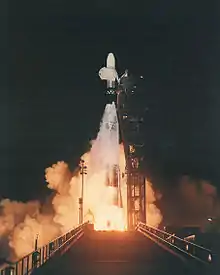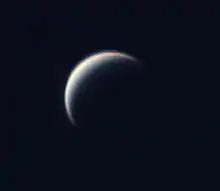Mariner 5
Mariner 5 (Mariner Venus 1967) was a spacecraft of the Mariner program that carried a complement of experiments to probe Venus' atmosphere by radio occultation, measure the hydrogen Lyman-alpha (hard ultraviolet) spectrum, and sample the solar particles and magnetic field fluctuations above the planet. Its goals were to measure interplanetary and Venusian magnetic fields, charged particles, plasma, radio refractivity and UV emissions of the Venusian atmosphere.
 Mariner 5 | |
| Mission type | Venus flyby |
|---|---|
| Operator | NASA / JPL |
| COSPAR ID | 1967-060A |
| SATCAT no. | 2845 |
| Mission duration | 1 year, 4 months (launch to last contact) |
| Spacecraft properties | |
| Manufacturer | Jet Propulsion Laboratory |
| Launch mass | 244.9 kilograms (540 lb) |
| Power | 170 W |
| Start of mission | |
| Launch date | June 14, 1967, 06:01:00 UTC |
| Rocket | Atlas-SLV3 Agena-D |
| Launch site | Cape Canaveral LC-12 |
| End of mission | |
| Last contact | Loss of contact December 4, 1967; briefly regained October 14, 1968[1][2] |
| Flyby of Venus | |
| Closest approach | October 19, 1967 |
| Distance | 3,990 kilometers (2,480 miles) |

Mariner 5 was actually built as a backup to Mariner 4, but after the success of the Mariner 4 mission, it was modified for the Venus mission by removing the TV camera, reversing and reducing the four solar panels, and adding extra thermal insulation.
Liftoff took place on June 14, 1967 from Cape Canaveral Air Force Station Launch Complex 12 on Atlas vehicle 5401. Booster performance was normal through the Atlas portion of the launch and the first Agena burn, with all systems operating at the proper level. During the second Agena burn, abnormal fluctuations in the engine chamber pressure occurred, however they did not preclude successful interplanetary injection. There had been several occurrences of this behavior on previous NASA and Air Force launches and a program was initiated to correct it which led to a redesign of the Agena turbopump gearbox. Mariner 5 flew by Venus on October 19 that year at an altitude of 3,990 kilometers (2,480 mi). With more sensitive instruments than its predecessor Mariner 2, Mariner 5 was able to shed new light on the hot, cloud-covered planet and on conditions in interplanetary space.
Radio occultation data from Mariner 5 helped to understand the temperature and pressure data returned by the Venera 4 lander, which arrived at Venus shortly before it. The Venera 4 and Mariner 5 data was subsequently analysed together under a combined Soviet–American working group of COSPAR in 1969,[3][4] an organization of early space cooperation.[5] With the data of these missions, it was clear that Venus had a very hot surface and an atmosphere even denser than expected.
The operations of Mariner 5 ended in November 1967 and it is now defunct in a heliocentric orbit.
Further communication attempts
Further communication attempts were tried, in a joint spacecraft solar wind / solar magnetic fields investigation with Mariner 4, back in communication with Earth after being out of telemetry for about a year or more around superior conjunction. During the experiment, both spacecraft were going to be on the same idealized magnetic field spiral carried out from the sun by the solar wind.
Between April and November 1968 NASA tried to reacquire Mariner 5 to continue probing interplanetary conditions. Attempts to reacquire Mariner 5 during June, July, and early August 1968 yielded no spacecraft signal.
On October 14, the receiver operator at DSS 14 obtained a lock on the Mariner 5 signal. A carrier wave was detected, but outside expected frequency limits and varying in wavelength. Signal strength changes indicated the spacecraft was in a slow roll. Nevertheless, it was possible to lock the spacecraft to an uplink signal, but no response was observed to any commands sent to it. Without telemetry and without any signal change in response to commands, there was no possibility to repair or continue to use the spacecraft. Operations were terminated at the end of the track from DSS 61 at 07:46 GMT on November 5, 1968.
Instruments
- Two-Frequency Beacon Receiver
- S-Band Occultation
- Helium Magnetometer
- Interplanetary Ion Plasma Probe for E/Q of 40 to 9400 Volts
- Celestial Mechanics
See also
References
- http://lasp.colorado.edu/home/missions-projects/quick-facts-mariner-5/
- https://www.drewexmachina.com/2017/06/15/the-return-to-venus-the-mission-of-mariner-5/
- Carl Sagan (September 1969). "The COSPAR Meetings in Prague". Icarus. 11 (2): 268–272. doi:10.1016/0019-1035(69)90052-9.
- "Report on the Activities of the COSPAR Working Group VII". Preliminary Report, COSPAR Twelfth Plenary Meeting and Tenth International Space Science Symposium. Prague, Czechoslovakia: National Academy of Sciences. May 11–24, 1969. p. 94.
- Sagdeev, Roald; Eisenhower, Susan (May 28, 2008). "United States-Soviet Space Cooperation during the Cold War". Retrieved July 19, 2009.
External links
| Wikimedia Commons has media related to Mariner 5. |


